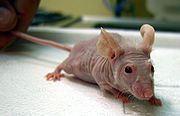
Nude mouse
Encyclopedia

Thymus
The thymus is a specialized organ of the immune system. The thymus produces and "educates" T-lymphocytes , which are critical cells of the adaptive immune system....
, resulting in an inhibited immune system
Immune system
An immune system is a system of biological structures and processes within an organism that protects against disease by identifying and killing pathogens and tumor cells. It detects a wide variety of agents, from viruses to parasitic worms, and needs to distinguish them from the organism's own...
due to a greatly reduced number of T cells. The phenotype, or main outward appearance of the mouse is a lack of body hair, which gives it the "nude" nickname. The nude mouse is valuable to research because it can receive many different types of tissue and tumor grafts, as it mounts no rejection
Rejection
The word "rejection" was first used in 1415. The original meaning was "to throw" or "to throw back".Rejection may mean:* Social rejection, in psychology, an interpersonal situation that occurs when a person or group of people exclude an individual from a social relationship* Transplant rejection,...
response. These xenografts are commonly used in research to test new methods of imaging and treating tumors. The genetic basis of the nude mouse mutation is a disruption of the FOXN1
FOXN1
Forkhead box protein N1 is a protein that in humans is encoded by the FOXN1 gene.-Further reading:...
gene.
Nomenclature
The nomenclature for the nude mouse has changed several times since their discovery. Originally they were described as nu and this was updated to Hfh11nu when the mutated gene was identified as a mutation in the HNF-3/forkhead homolog 11 gene. Then in 2000 the geneGene
A gene is a molecular unit of heredity of a living organism. It is a name given to some stretches of DNA and RNA that code for a type of protein or for an RNA chain that has a function in the organism. Living beings depend on genes, as they specify all proteins and functional RNA chains...
responsible for the mutation was identified as a member of the Fox gene family and the nomenclature was updated to Foxn1nu.
History and significance
Nude mice were first discovered in 1962 by Dr. N. R. Grist at RuchillRuchill
Ruchill is a district in the city of Glasgow. It lies within the Canal Ward of North Glasgow in the area between the Maryhill and Possilpark areas of the city. It has traditionally been characterised by a high degree of deprivation and social problems...
Hospital's Brownlee virology laboratory in Glasgow
Glasgow
Glasgow is the largest city in Scotland and third most populous in the United Kingdom. The city is situated on the River Clyde in the country's west central lowlands...
. Because they lack a thymus, nude mice cannot generate mature T lymphocytes. Therefore they are unable to mount most types of immune responses, including:
- antibody formation that requires CD4CD4CD4 is a glycoprotein expressed on the surface of T helper cells, monocytes, macrophages, and dendritic cells. It was discovered in the late 1970s and was originally known as leu-3 and T4 before being named CD4 in 1984...
+ helper T cells - cell-mediated immune responsesCell-mediated immunityCell-mediated immunity is an immune response that does not involve antibodies but rather involves the activation of macrophages, natural killer cells , antigen-specific cytotoxic T-lymphocytes, and the release of various cytokines in response to an antigen...
, which require CD4+ and/or CD8+ T cells - delayed-type hypersensitivityHypersensitivityHypersensitivity refers to undesirable reactions produced by the normal immune system, including allergies and autoimmunity. These reactions may be damaging, uncomfortable, or occasionally fatal. Hypersensitivity reactions require a pre-sensitized state of the host. The four-group classification...
responses (require CD4+ T cells) - killing of virus-infected or malignantMalignantMalignancy is the tendency of a medical condition, especially tumors, to become progressively worse and to potentially result in death. Malignancy in cancers is characterized by anaplasia, invasiveness, and metastasis...
cells (requires CD8+ cytotoxic T cells) - graft rejection (requires both CD4+ and CD8+ T cells)
Because of the above features, nude mice have served in the laboratory to gain insights into the immune system
Immune system
An immune system is a system of biological structures and processes within an organism that protects against disease by identifying and killing pathogens and tumor cells. It detects a wide variety of agents, from viruses to parasitic worms, and needs to distinguish them from the organism's own...
, leukemia
Leukemia
Leukemia or leukaemia is a type of cancer of the blood or bone marrow characterized by an abnormal increase of immature white blood cells called "blasts". Leukemia is a broad term covering a spectrum of diseases...
, solid tumors, AIDS
AIDS
Acquired immune deficiency syndrome or acquired immunodeficiency syndrome is a disease of the human immune system caused by the human immunodeficiency virus...
and other forms of immune deficiency as well as leprosy
Leprosy
Leprosy or Hansen's disease is a chronic disease caused by the bacteria Mycobacterium leprae and Mycobacterium lepromatosis. Named after physician Gerhard Armauer Hansen, leprosy is primarily a granulomatous disease of the peripheral nerves and mucosa of the upper respiratory tract; skin lesions...
.
Moreover, the absence of functioning T cells prevents nude mice from rejecting not only allografts, but they cannot even reject xenografts; that is, grafts of tissue from another species.
Most strains of nude mice are slightly "leaky" and do have a few T cells, especially as they age. For this reason, nude mice are less popular in research today, since knockout mice with more complete defects in the immune system have been constructed (e.g. RAG1 and RAG2 knockout mice).

